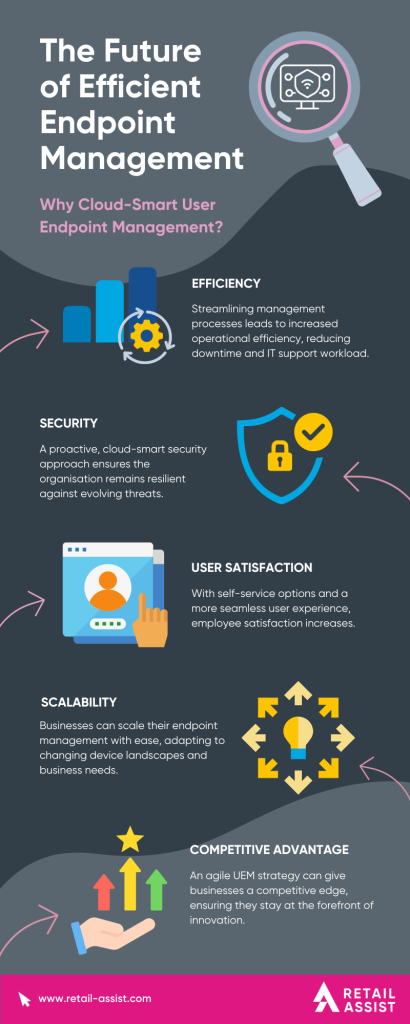Written by Andréa Williams, Head of Marketing
SubscribeIn today’s fast-paced digital landscape, the management and security of endpoints – a term encompassing everything from your laptop to your smartphone – are paramount. Traditional methods have served their purpose, but in an era where remote work and diverse device ecosystems are prominent, a smarter, more agile approach is needed. Cloud-Smart Unified Endpoint Management (UEM) is a game-changing strategy that’s transforming the way businesses operate and secure their devices.

To truly understand this paradigm shift, let’s break it down. Unified Endpoint Management (UEM) is all about streamlining the management and security of various devices within an organisation. It’s the one-stop shop for overseeing everything from software updates to device compliance checks.
So, what sets Cloud-Smart UEM apart? It’s about leveraging the cloud, to make endpoint management more efficient and adaptable. It’s about optimising your strategy to better align with your business’s unique needs.
According to Gartner, by 2023, 70% of organisations will implement a “cloud-first but not cloud-only” strategy, recognising the need for flexibility.
So, how does Cloud-Smart UEM compare to traditional methods?
Traditional UEM
These solutions often rely on on-premises infrastructure and manual processes. They struggle to keep up with the demands of modern device ecosystems and remote work scenarios. They can be rigid and time-consuming, lacking automation and adaptability.
Cloud-Smart UEM
This approach leverages cloud technology, making it more scalable, adaptable, and user-centric. It automates routine tasks, integrates seamlessly with other systems, and offers robust security measures. The emphasis is on agility, flexibility, and efficiency.
Cloud-Smart UEM isn’t just a buzzword; it’s a necessity in our modern business landscape:
1. Flexibility
With Cloud-Smart UEM, you have the flexibility to manage a wide array of devices, regardless of operating system or form factor. It’s not about being bound to a single platform; it’s about adaptability.
2. Cloud-Centric Approach
The cloud is at the heart of this strategy. It’s all about harnessing the power of cloud-based services, allowing you to scale resources up or down to meet changing device requirements.
3. Automation and AI
Automation and artificial intelligence streamline the management process. Routine tasks like patch management and threat detection become more efficient.
4. User-Centric
It’s all about the user experience. With self-service options, your employees gain more control over their devices, reducing the IT support burden.
5. Remote Work Readiness
A survey by Forbes found that 65% of workers desire to work remotely all the time, and 32% prefer a hybrid schedule. Currently, 12.7% of full-time employees work from home and 28.2% have adapted to a hybrid work model, illustrating the rapid normalisation of remote work and proving the necessity of remote work readiness. Cloud-Smart UEM empowers businesses to manage and secure devices, no matter where they are.
“As of 2023, 12.7% of full-time employees work from home, while 28.2% work a hybrid model” Forbes
The adoption of Cloud-Smart UEM has far-reaching implications for business operations.
Cloud-Smart UEM doesn’t just change how businesses operate; it impacts their overall strategy.
Where to Start? Understand Your Goals
The goals of UEM typically revolve around enhancing security, efficiency, and user experience in the management of these devices. It’s important for organisations to define their specific UEM goals based on their unique needs, industry, regulatory requirements, and technology landscape. Setting clear and measurable objectives is crucial for the successful implementation of a UEM strategy.
We recently hosted a Discussion Room at our Client Summit focused on uncovering the maturity of cloud-first UEM strategies among popular UK high street retailers. Here’s what they’re aiming for:
A report by Statista states that in 2021, the global cloud infrastructure services market was valued at over $150 billion, a figure expected to increase significantly in the coming years.
Cloud-Smart UEM is more than just a trend; it’s a strategic shift that addresses the modern complexities of device management and security. It’s about staying adaptable, efficient, and user-centric. By embracing this approach, businesses can not only optimise their operations but also gain a competitive edge in a rapidly evolving digital landscape.
Written by Andréa Williams, Head of Marketing
Share this post
SubscribeWe think you might like these posts too
© 2025 Retail Assist Limited. The Hub Floor 5A, 40 Friar Lane, Nottingham, NG1 6DQ.
Registered in England. Company number: 03790674
info@retail-assist.com | +44 (0)115 904 2777
Website Designed & Built by we are CODA